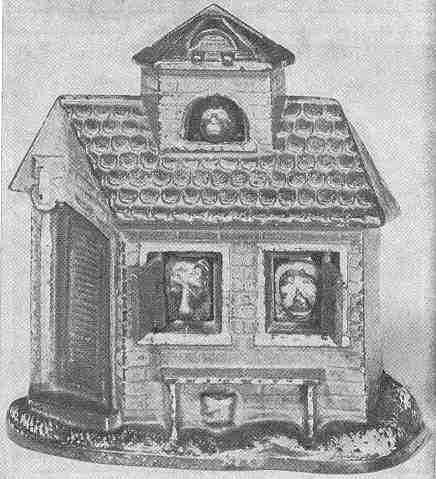Zoo Bank
by F.H. Griffith - HOBBIES Magazine - November, 1963

Alphabetically speaking, our choice of the 115th mechanical bank in the numerical classification is most certainly last, but assuredly not least. This is the Zoo Bank, and to the best of the writer’s knowledge, the only mechanical bank having a name beginning with the letter Z. As a matter of fact, until the first part of the year, only two letters in the alphabet, Q and X, were not represented by names in mechanical banks. Now only X remains since a Queen Victoria Bank turned up some months ago. This is a bust type bank made in England. When a coin is deposited in the crown atop her head the eyes blink. The bank was made in celebration of the Jubilee of 1887, the 50th reigning year of Queen Victoria. As to the letter X, there are some who may feel this is represented by the X-Ray Bank, and this could be accepted in this fashion, except for the fact that the full proper name appears on the bank itself as "The Smyth X-Ray Bank" (HOBBIES, April, 1961).
The Zoo Bank is one of the so called "little" mechanical banks, and some others in this category are the Afghanistan Bank, Girl In Victorian Chair, and Elephant And Three Clowns On Tub. The Zoo, like the Elephant And Three Clowns, is very nicely proportioned for so small a bank. Also it has excellent action considering its size which is 4¼" both in height and width, and 1½" in depth. Further, while other mechanical banks utilize various animals in their action, this bank has the distinction of being the only one to actually represent a Zoo house.
No dates or patent information appear on the Zoo Bank, nor does the writer have in his possession any old catalogs or other material that picture or describe the bank. So far the writer has also been unable to locate any patent papers that would possibly apply to the action or mechanism involved. Using the bank itself as a guidepost we can fairly accurately narrow the possible manufacturers down to two concerns. Wording appears inscribed on the back of the bank as follows: "Zoo Bank." Under this, "Press the Monkey," and below this the number "134." The same method of wording was used on the Uncle Remus Bank in the same fashion, along with the number "136." Using this along with other characteristics of the Zoo bank we can reasonably assume that either Kyser & Rex of Philadelphia, Pa., or the Mechanical Novelty Works of New Britain, Conn., made the bank.
Leon Perelman of Merion, Pa. is the collector who owns the pictured bank. It is a nice original specimen with good paint and the colors are as follows: The house and cupola are red and each has a gray roof highlighted with gold. The shutter-type door and the shutters on the two windows are green with gold outlining and striping. The bench and bucket in front of the house are done in gold as is the pulley-lift arrangement left top of the door. The small patch of ground around the base of the house is done in green with yellow and red highlighting. The face of the monkey which appears in the cupola is black and bronze, with small white eyes and black pupils. The face of the bear in the left window is black and silver with a red mouth and same type eyes as the monkey. The lion in the right window is tan with brown, a red mouth and black eyes.
The bank as pictured is shown after the action has taken place. To prepare the bank for operation, using the picture as a guide, one must first manually close each of the two shutters on the windows. This causes the faces of the bear and lion to recede into the bank. At the same time the face of the monkey moves forward into the window of the cupola. The shutters, due to a spring arrangement inside, snap into place and stay closed. To operate the bank a coin is placed in the provided slot in the roof of the cupola. This rests at a given point partly exposed, it does not fall into the bank. The face of the monkey is then pressed. This causes the lion and bear to move forward into their positions in the windows and the shutters fly open exposing their faces. At the same time the coin drops into the bank automatically. A small key-lock type coin trap is provided in the base for the removal of accumulated coins.
The Zoo Bank is a very nice little item, particularly difficult to find in complete original condition and in good original working order. It is a bank that is securely held together by means of peened over pins in the casting. Since it could not readily be taken apart apparently children were prone to try to pry it open, pull on the shutters, or try to pry the lion or bear out. The mechanism as compared to many of the more sturdy mechanical banks is rather delicate, small in size, and would tend to get out of order with any degree of rough treatment.
